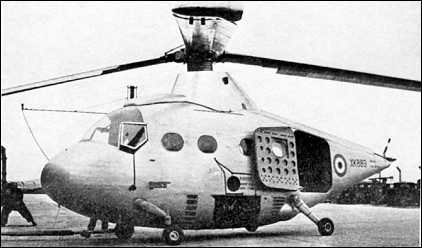
| Hunting Percival P.74 1955 - project |  |
 |

| Hunting Percival P.74 1955 - project |  |
 |
|
The P.74 was intended as a demonstrator for a new type of helicopter. It worked on the tip-jet principle, but unlike the Hiller Hornet with its individual ramjets, the P.74 had a gas generator under the cabin floor which fed compressed air through triple ducts to the three-bladed rotor, each blade of which had triple ejector ducts. Months of testing in a static rig showed up many problems with the power system, which refused to develop full power and maximum gas flow. Finally these problems were fixed and a first flight attempted. Despite the efforts of two pilots on the very stiff controls, the P.74 resolutely refused to fly. One engineer associated with the project says that a consultant designer used the wrong formula for calculating lift. All the figutes added up but the P.74 went nowhere. Actually it was ordered to be towed across the airfield out of sight, and that is about the last anyone heard of it. Jim Winchester "The World's Worst Aircraft", 2005
In 1951, a Helicopter Division was formed by Hunting Percival and design work commenced on a medium-sized helicopter designated P.74. This machine had a teardrop-shaped fuselage with the two-seat cockpit in the nose and a large cabin running the full length of the fuselage. Beneath the cabin floor was a Napier Oryx gas generator which fed compressed air to the tips of the three rotor blades. The prototype was completed in the spring of 1956, carrying the military serial number XK889. Ground testing commenced but the Oryx engine was insufficiently powerful and the P.74 failed to fly. It was planned to fit a more powerful Rolls-Royce RB.108 turbine, but the rationalisation of the heli-copter industry later that year resulted in the P.74 project being cancelled. R.Simpson "Airlife's Helicopter and Rotorcraft", 1998
- The rotor blades were not adjusted by actuators at the hubs as on most helicopters but by ailerons on the trailing edges. Pitch was controlled with a screw jack. - Plans to fit a more powerful Rolls-Royce RB.108 turbine engine (which should have got the P.74 into the air) were abandoned when the helicopter industry was rationalized. A proposed 10-passenger model called P.105 using the Oryx system was never built. - The gas-generating engines were mounted under the floor with the hot and noisy gas pipes running up the cabin walls between rows of seats. - The test pilot said 'the cockpit, flying controls and engine controls were designed without any input from a pilot'. - There was no entrance door or escape hatch near the cockpit. The only way in or out was the door at the rear of the port side of the fuselage. - Being propelled by jets at the tips, the P.74 had almost no torque, which was controlled by a very small tail rotor. - The P.74's undercarriage consisted of four wheels, the forward two of which were castoring.
|